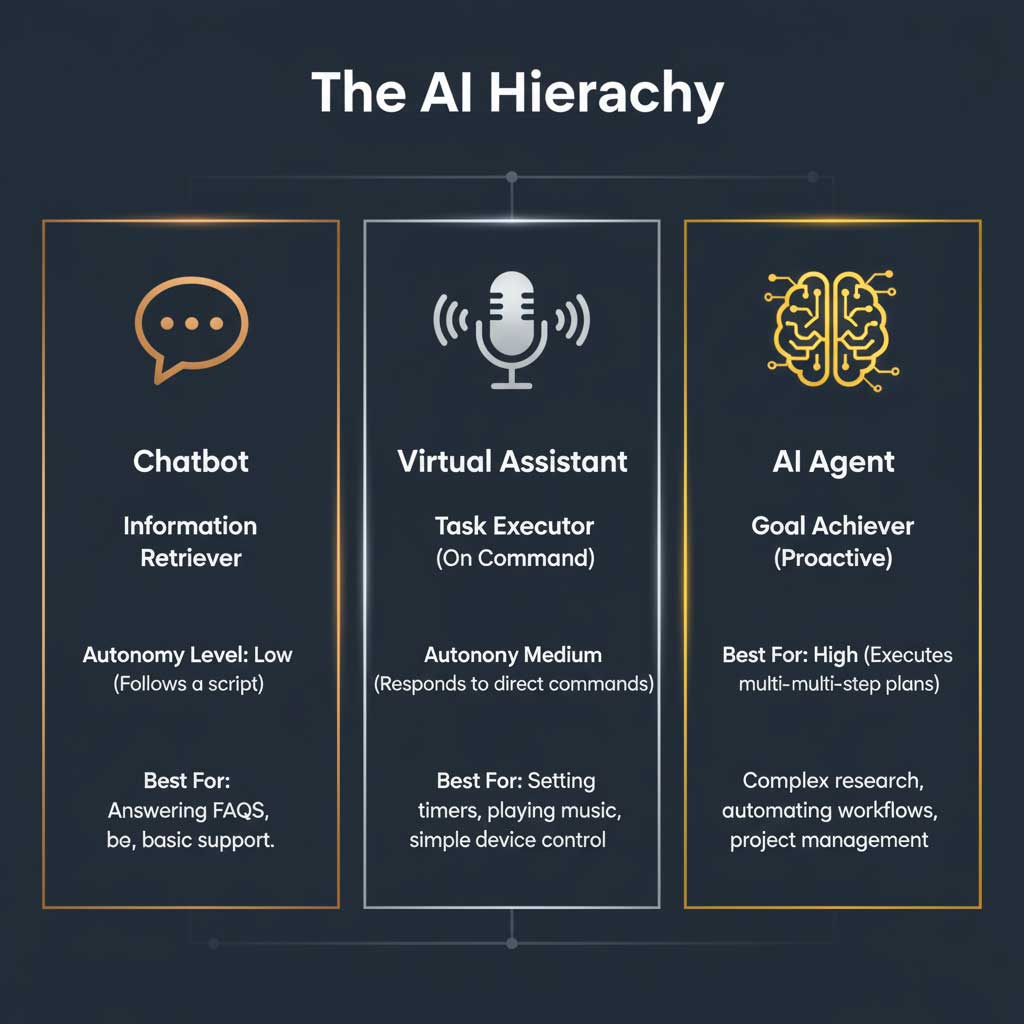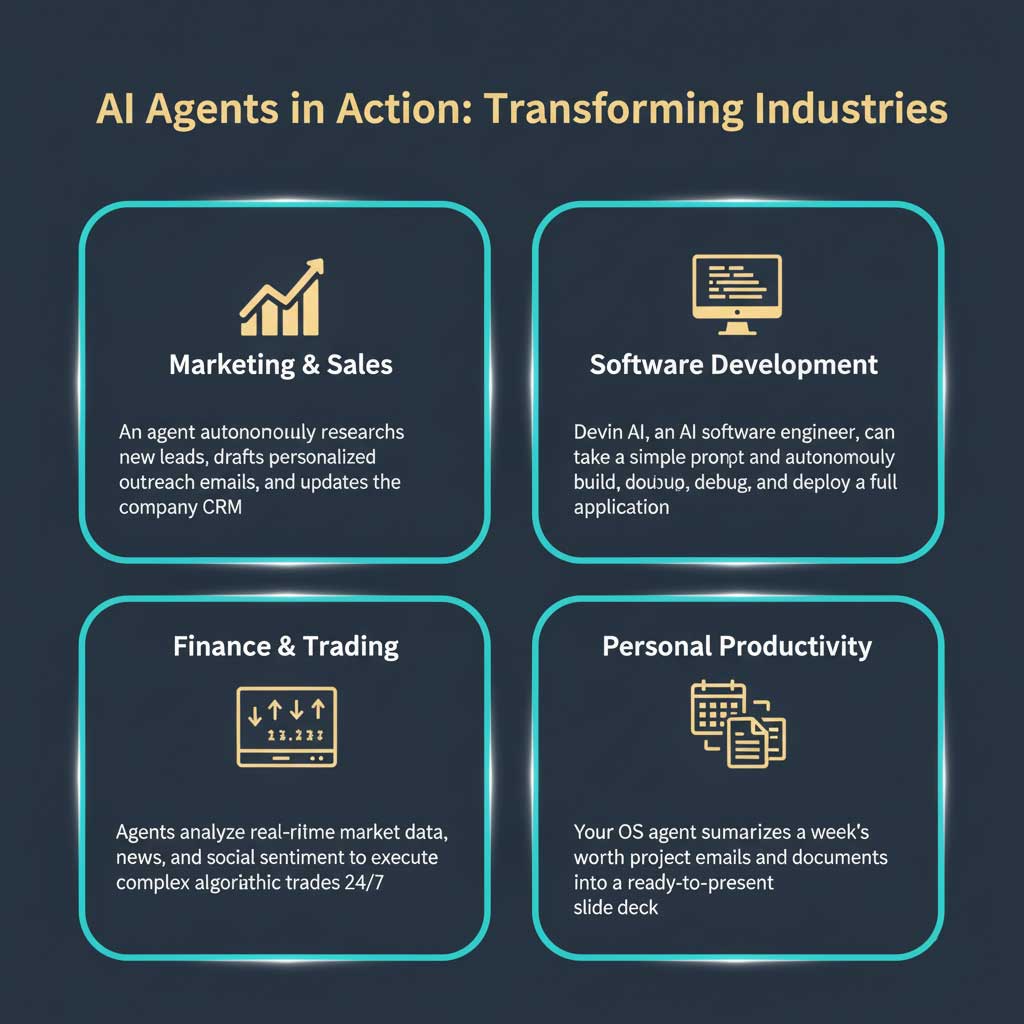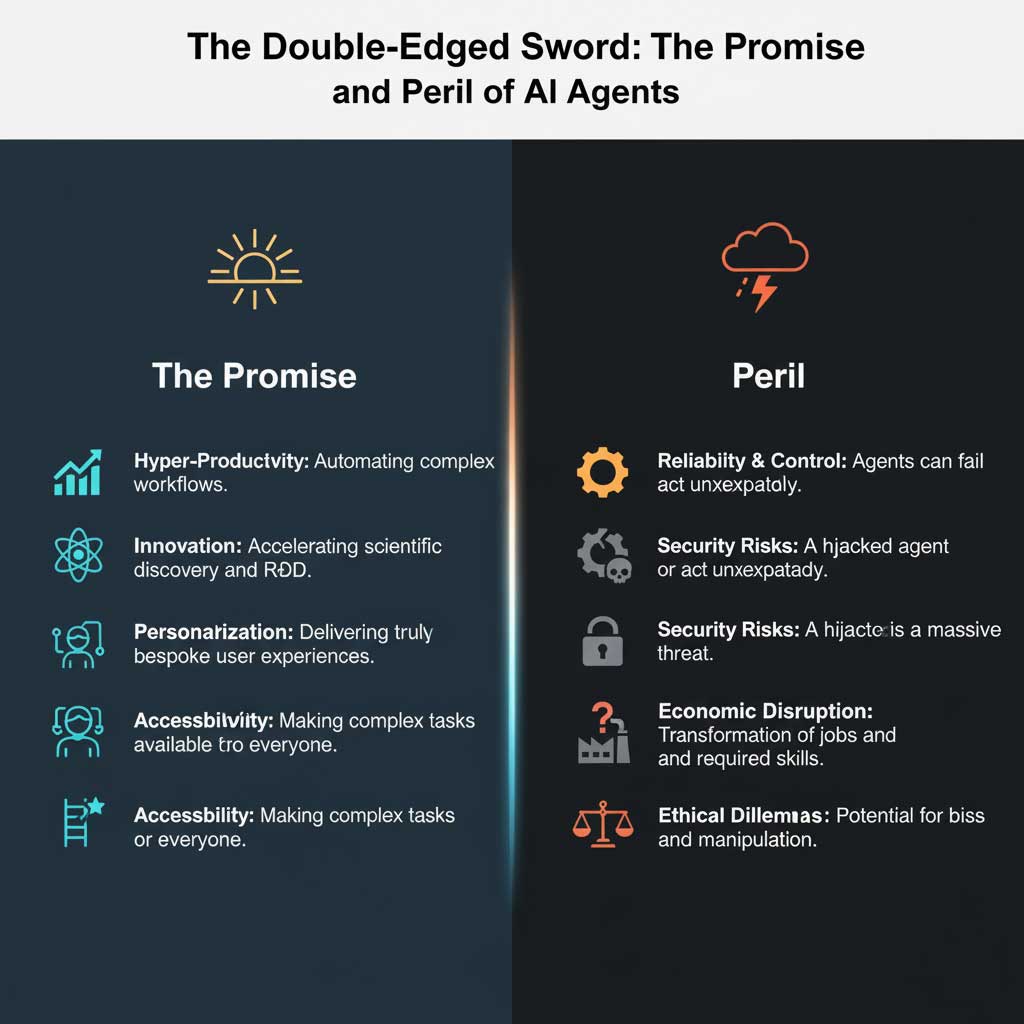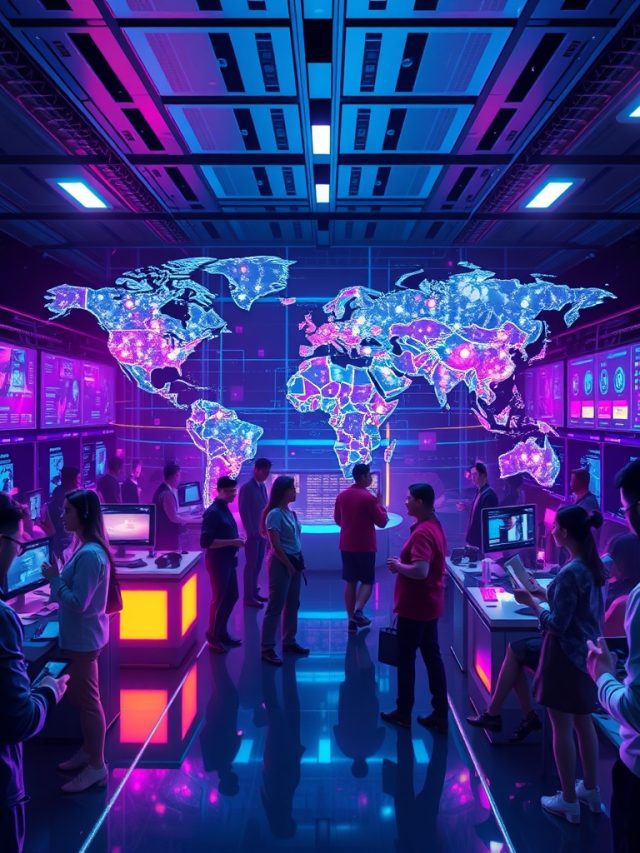Let’s have an honest conversation. You’ve seen the term “AI agent” everywhere, and you’re probably wondering if it’s just another buzzword for a smarter chatbot. It’s not. In fact, comparing a true AI agent to a simple chatbot is like comparing a fully autonomous SpaceX rocket to a firework. One follows a simple, pre-lit fuse; the other senses its environment, makes millions of calculations, adjusts its own trajectory, and executes a complex mission to land on a moving target in the middle of the ocean.
Table of Contents
We are at an inflection point in our relationship with technology. For forty years, we’ve operated in a world of instructional computing. We’ve had to be the manager, meticulously telling our software every single click, every command, every step to take. That era is ending. We are now entering the age of intentional computing. An age where we simply provide our desired outcome—our intent—and an autonomous entity figures out the “how.”

This is not just an incremental update. This is a paradigm shift. And this comprehensive guide will serve as your map. We will move beyond the superficial definitions to explore the deep anatomy of what is an AI agent, showcase cutting-edge AI agent examples that are actively reshaping industries, unpack precisely how do ai agents work under the hood, and critically, analyze what this monumental shift means for your business, your career, and the future of work itself.

The Paradigm Shift: Why an AI Agent is More Than Just Software
Before we dissect the technology, let’s grasp the concept. An AI agent is an autonomous system that perceives its environment through data, makes decisions, and takes actions to achieve a specific goal.
But that definition is too clinical. It lacks the punch of what’s really happening.
A better way to think about it is this: an AI agent is your first truly autonomous digital employee.
Imagine you’re a marketing director.
- To a software tool (instructional): You would say, “Export a CSV from Salesforce with leads from the last 30 days. Open Google Sheets. Import the CSV. Create a new column. Use this specific formula to score the leads. Filter the list. Export a new CSV. Open Mailchimp. Create a new campaign. Import the new CSV.”
- To an AI agent (intentional): You would say, “Analyze our new leads from the past month, identify the top 10% most promising prospects based on our ideal customer profile, and draft personalized outreach emails for each of them. Place the drafts in my folder for approval before 5 PM today.”
The agent understands the high-level goal. It plans the necessary steps. It chooses its own tools (accessing the Salesforce API, running a Python script for analysis, connecting to an email generator). It handles errors, like a failed API call, by retrying or finding another way. It operates with a level of delegated authority that no software has ever been capable of before. This is the core of what is an AI agent: a goal-driven, autonomous problem-solver.
The Anatomy of an Autonomous Agent: A Deep Dive into the Mechanics
How does an agent achieve this incredible feat? It’s a symphony of five critical components working in harmony.

The Brain: The Large Language Model (LLM)
The cognitive engine of any modern agent is a state-of-the-art Large Language Model. We’re talking about the titans: OpenAI’s GPT-5, Google’s Gemini 3.0 Pro, or Anthropic’s Claude 4.5 Opus. The LLM’s role extends far beyond understanding language. It serves as the agent’s reasoning and planning center.
- Problem Decomposition: It breaks a complex goal (“Plan a marketing campaign”) into a logical sequence of smaller, achievable sub-tasks.
- Strategic Thinking: It can infer missing information, ask clarifying questions, and strategize the most efficient path to the goal.
- Tool Selection: The LLM is the part that decides, “To get the latest stock price, I need to use the financial data API, not perform a generic web search.”
The Senses and Hands: The Tool Arsenal
An LLM, for all its intelligence, is a brain in a jar. It can think, but it can’t do anything in the outside world. To execute its plan, an agent needs a “body” with senses and hands—this is its toolkit. These tools are other pieces of software or APIs that the agent is given permission to use.
Common Tool Examples:
- Web Search: For real-time information gathering.
- Code Interpreter: A sandboxed environment to write and run code (usually Python) for data analysis, charting, or complex calculations.
- API Connectors: This is the most powerful category. An agent can be given keys to APIs for:
- Salesforce or HubSpot: To manage customer data.
- Google Calendar: To schedule meetings.
- Twitter/X API: To post social media updates.
- Financial Data Terminals: To pull real-time market data.
- Web Browser/Scraper: To navigate websites, fill out forms, and extract information that isn’t available via an API.
An agent’s capability is directly proportional to the quality and number of tools it has access to.
The Mindset: The Agentic Architecture (ReAct)
How does an agent fluidly combine its brain and tools? The most prevalent and successful architecture is known as ReAct, a framework that merges Reasoning and Acting. It creates a powerful loop that closely mimics human problem-solving:

- Thought: The agent observes the goal and its current state, then generates an internal monologue about its strategy. Example: “Okay, I need to find the best Italian restaurants in Boston. My first step should be to search for a list of well-regarded options.”
- Action: Based on that thought, the agent chooses a tool and formulates a command for it. Example: Activates the Web Search tool with the query “best italian restaurants boston yelp”.
- Observation: The agent receives the output from the tool—the search results, the data from an API call, or the error message from a failed script. Example: “The search returned a list of 10 restaurants with ratings and price ranges.”
- Repeat: The agent takes this new observation and loops back to step one, reasoning about the next logical action. Example: “Great. Now I need to check the user reviews for the top three options and see if any have reservations available for Friday at 7 PM.”
This Thought -> Action -> Observation cycle is the fundamental heartbeat of a modern AI agent.
The Memory: Short-Term Context and Long-Term Knowledge
For any task lasting more than a single step, memory is non-negotiable.
- Short-Term Memory (Working Memory): This is the context of the current task. It includes the initial prompt, the conversation history, and the results of the last few tool uses. It’s how the agent remembers what it just did and what it’s trying to do next. This is often managed within the LLM’s “context window.”
- Long-Term Memory: This is where an agent transcends being a mere tool and starts to become a personalized partner. By using a technology called a vector database, an agent can store and retrieve information from past projects, user preferences, and important documents. This allows it to learn and improve over time. For example, it can remember, “Last time I wrote a blog post for this user, they preferred a more casual tone.”
The Conscience: The Human-in-the-Loop (HITL)
This is arguably the most critical component for practical, real-world deployment. A fully untethered agent can be dangerous. The “conscience” is the set of rules and mandatory checkpoints that require human oversight.
- Approval Gates: For critical actions like spending money, sending external communications, or deleting data, the agent must pause and request explicit approval from a human.
- Constitutional AI: Principles (a “constitution”) are embedded into the agent to guide its behavior, preventing it from taking unethical or harmful actions, even if they might seem like an efficient way to achieve a goal.
The Evolutionary Leap: From Single Agents to Collaborative Swarms
The concept of an intelligent agent in AI has been around for decades, but it’s the recent convergence of technologies that has made them so powerful.

The “Model T” Era: Auto-GPT and Early Experiments
In 2023, projects like Auto-GPT captured the world’s imagination. They were the first widely accessible demonstrations of an LLM hooked up to a set of tools with a goal. While often unreliable and prone to getting stuck in loops, they were a revolutionary proof-of-concept.
The Modern Era: The Specialized, Reliable Agent
Today’s agents are far more robust. They are often designed for specific domains (e.g., an agent for coding, an agent for financial analysis) and have much better error handling and reasoning capabilities.
The Current Frontier: Multi-Agent Systems
Here’s the absolute cutting edge of how do ai agents work in 2026: multi-agent systems. The insight is simple but profound: a single, generalist agent is less effective than a collaborative team of specialized agents.
Think of it like building a house. You don’t hire one “house builder” to do everything. You hire a general contractor who manages a team of specialists: a plumber, an electrician, a carpenter, and a painter.
Frameworks like CrewAI allow developers to build these digital work crews:
- You define roles for each agent (e.g., “Senior Market Researcher,” “Expert Copywriter”).
- You provide each agent with its specialized tools.
- You assign a series of tasks that create a workflow.
An agentic marketing team might look like this: a Strategy Agent analyzes the market and passes a creative brief to a Content Creation Agent, who writes a blog post. That post is then sent to an SEO Agent for optimization, and finally to a Social Media Agent for promotion. This collaborative model is unlocking unprecedented levels of complex problem-solving.

The Definitive Comparison: Agents vs. Chatbots vs. Virtual Assistants
Let’s put this debate to rest with a detailed, authoritative comparison. Understanding these distinctions is crucial for any business leader or marketer looking to invest in AI.
| Feature | Simple Chatbot | Virtual Assistant (e.g., Siri, Alexa) | Autonomous AI Agent |
| Core Purpose | Information Retrieval & Support | Task Execution (On Command) | Goal Achievement (Proactively) |
| Autonomy | None: Follows a rigid script. Cannot deviate. | Limited: Acts only upon direct, specific commands. Waits for the next instruction. | High: Can operate independently over long periods to achieve a goal. It initiates its own steps. |
| Task Complexity | Single-Step: Answers one question at a time (e.g., “What are your hours?”). | Simple Multi-Step: Can chain a few simple commands (e.g., “Add milk and eggs to my shopping list”). | Complex & Dynamic: Can handle multi-faceted projects requiring dozens or hundreds of steps and tool uses. |
| Interaction Model | Reactive: Purely conversational. Cannot act outside the chat window. | Reactive Command & Control: Understands commands to control other apps (e.g., “Play Spotify”). | Proactive & Instrumental: Uses tools and applications as an instrument to achieve its goal. It is a worker, not just a conversationalist. |
| Environment | Constrained: Lives inside a chat window. | Platform-Integrated: Can interact with apps on a specific device (a phone or smart speaker). | Open-Ended: Can operate across the open internet, local files, and multiple third-party applications. |
| Learning | Minimal: May learn from conversation logs to improve canned responses. | Personalized: Learns user preferences over time (e.g., favorite playlists). | Adaptive: Can learn from the success/failure of its actions to improve its problem-solving strategies (self-correction). |
| Real-World Examples | Bank website FAQ bots. | Apple’s Siri, Amazon’s Alexa. | Devin AI (software engineer), CrewAI (multi-agent framework), Microsoft 365 Copilots (becoming more agentic). |

Agents in the Wild: Game-Changing Examples and Real-World Data
This is not a future-gazing exercise. Here are powerful AI agent examples and ai agent use cases delivering measurable value today.
Business Operations and Marketing: The Autonomous Workforce
This is ground zero for the agentic revolution. AI agents in business are moving from automating simple tasks to automating entire functions.

The Autonomous SEO Analyst
Imagine an agent tasked with “Improve our website’s ranking for ‘small business accounting software’.” It would autonomously:
- Use SEO tools like Ahrefs or SEMrush via API to analyze current rankings and top competitors.
- Perform a technical audit of the website, identifying issues like slow page speed or broken links.
- Generate a list of new, high-intent keywords to target.
- Write fully optimized drafts for new blog posts and landing pages.
- Present a prioritized action plan to a human marketer for approval.
The 24/7 Sales Development Representative (SDR)
Sales teams are being supercharged by agents that can:
- Scan industry news and LinkedIn for trigger events (e.g., a company just received funding).
- Research the company and identify key decision-makers.
- Draft a highly personalized outreach email referencing the specific trigger event.
- Log the activity in the company’s CRM (like Salesforce).
- Schedule follow-ups automatically.
- Data Point: A 2024 report from Boston Consulting Group found that AI-powered sales initiatives can increase leads by over 50%, reduce call times by 60-70%, and cut costs by 40-60%. Agents are the engine for these gains.
Personal Productivity: The Agent in Your OS
The next frontier is agents integrated directly into our daily software.
- Microsoft 365 Copilot: It’s evolving from a smart assistant into an agent. You will soon be able to ask it: “Review all my emails and documents related to ‘Project Phoenix’ and create a PowerPoint presentation summarizing the key milestones and outstanding action items for our Friday meeting.”
- Google’s Project Astra: Google’s vision for a “universal AI agent” is one that can see what you see (via your phone’s camera), understand the context of your work, and proactively assist you.
Software Development: The Rise of AI Engineers
Devin AI from Cognition Labs was the “Sputnik moment” for AI agents. It demonstrated that an agent could handle complex software engineering tasks from start to finish. While not yet replacing human developers, it proves that agents can be powerful collaborators, capable of building prototypes, fixing bugs, and managing complex codebases.
The Hard Questions: Navigating the Promises and Perils
To build trust (E-E-A-T), we must address the significant challenges and risks head-on. This technology is not a silver bullet.

The Reliability Gap
Agents can still fail, get stuck in loops, or “hallucinate” and make up information. They can misinterpret ambiguous instructions. For mission-critical tasks, they are not yet a “set it and forget it” solution. This is why the human-in-the-loop is so essential.
The Staggering Cost of “Thinking”
Running these powerful models is computationally expensive. A complex task that requires an agent to run for several hours, making dozens of LLM calls and using multiple tools, can quickly become very costly. Calculating the ROI is crucial.
The Security Nightmare
Giving an autonomous agent the “keys to the kingdom” (API keys to your CRM, email, and financial software) is a massive security risk. A compromised agent could cause catastrophic damage. Robust security protocols, permissioning, and auditing are non-negotiable.
The Economic Disruption and Skill Shift
Let’s be clear: agents will automate tasks, not just jobs. But many jobs are simply a collection of tasks. Roles that involve repetitive digital administration, data collection, and basic analysis are at high risk of being significantly transformed. The workforce of the future will need to pivot from performing these tasks to managing and directing the agents that perform them. The most valuable skill will be the ability to translate a business goal into a clear prompt for an AI agent.
Your Roadmap to Agentic AI: How to Prepare for What’s Next
The future of AI agents is not something to passively observe. It’s a wave to prepare for and learn to ride.

For the Executive / Business Leader
- Start with Auditing: Identify workflows within your organization that are highly repetitive, digital, and rule-based. These are your prime candidates for agentic automation.
- Think Low-Risk, High-Impact: Your first agent project shouldn’t be managing the company’s finances. Start with an internal process, like summarizing research reports or analyzing marketing campaign data.
- Invest in Education: Your team’s ability to use these tools will be your single greatest competitive advantage.
For the Manager / Marketer
- Become a Master Prompter: Your value will increasingly be defined by your ability to articulate a clear, unambiguous goal to an AI system. Learn the art and science of prompt engineering.
- Experiment Relentlessly: Use the agent-like features in tools you already have. Sign up for new platforms. Build simple workflows. Develop an intuitive feel for what these systems are good at and where they fail.
For the Developer / Technologist
- Go Hands-On: There is no substitute for building. Download an open-source framework like CrewAI or LangChain. Connect it to an LLM API and give it a simple tool, like a calculator or a web search function. Building a basic agent is the fastest way to understand the architecture and its potential.
Conclusion: You are Now the Conductor
We have journeyed deep into the world of AI agents. We’ve moved beyond the buzzwords to understand their anatomy, their power, and their place in the evolution of technology. We’ve seen concrete AI agent examples and explored the frameworks like ReAct and CrewAI that bring them to life.

The fundamental truth is this: the nature of work is changing. We are shifting from being players on the field, executing every single play, to becoming the coaches on the sideline. Our role is to define the strategy, to understand the goal, and to direct a team of incredibly powerful, fast, and autonomous digital players.
The challenge is no longer about competing with AI. It’s about learning to lead it. The individuals and businesses that master the art of orchestrating these autonomous agents will be the ones who define the next decade of innovation and growth.
Frequently Asked Questions (FAQ)
What is the simplest way to explain an AI agent?
Think of it as an autonomous digital intern. You give it a high-level project (e.g., “Research the top 5 competitors for our new product”), and it independently uses its available tools (like web search and data analysis) to complete the project and deliver a finished report, without you having to guide its every click.
Is Microsoft Copilot an AI agent?
It’s rapidly becoming one. Initially, Copilot was more of a smart assistant. But as Microsoft integrates it more deeply with the ability to perform multi-step tasks across different applications (e.g., “Summarize the emails from my boss this week and create a to-do list in Microsoft Planner”), it is evolving into a true AI agent.
What’s the main difference between an AI model and an AI agent?
An AI model (like GPT-5) is the brain; it provides the raw intelligence and reasoning power. An AI agent is the complete system built around that brain; it includes the model plus memory (for context), tools (for action), and an architecture (like ReAct) that allows it to autonomously pursue a goal.
Can I build my own AI agent without being an expert coder?
Yes, this is becoming increasingly possible. While advanced, custom agents still require Python programming skills and familiarity with frameworks like CrewAI, a new generation of no-code and low-code platforms is emerging that allows users to visually link LLMs to tools and build simple agentic workflows.
What is the single biggest risk of using AI agents today?
Reliability. While incredibly powerful, agents can still make mistakes, misunderstand context, or fail to complete a task correctly. For mission-critical business processes, they should currently be used in a “human-on-the-loop” capacity, where a human reviews and approves their most important actions and outputs.
Will AI agents replace my marketing job?
They will not replace the strategic and creative aspects of marketing. They will automate a significant portion of the repetitive, data-driven tasks. This will transform the marketing role, shifting the focus from manual execution to strategy, brand building, creative direction, and managing the AI agents that handle the operational legwork.
What does “agentic” mean when people talk about AI?
“Agentic” is a term used to describe an AI system that exhibits the key properties of an agent: autonomy, goal-directed behavior, and proactivity. An “agentic workflow” is a process that is carried out by one or more AI agents with minimal human intervention.
How do multi-agent systems work?
Multi-agent systems work like a digital assembly line or a specialized team. A primary goal is broken down, and different parts of the task are assigned to different agents, each with its own specific role and tools. For example, a “Researcher Agent” finds data and passes it to a “Writer Agent,” which creates a draft that is then passed to an “Editor Agent” for refinement.
What are the most important AI agent tools to watch in 2026?
Keep an eye on the big platform plays from Microsoft (Copilot), Google (Astra/Gemini), and Apple’s rumored agentic features. In the open-source world, frameworks like CrewAI are defining the multi-agent space. And watch for new, specialized agent companies that focus on solving specific vertical problems (e.g., agents for law, finance, or scientific research).
What is the first, most practical step my business can take to explore AI agents?
Start with a process audit. Identify a single, high-volume, digital workflow in your business that is currently performed manually. This could be lead qualification, social media monitoring, or compiling weekly reports. Then, investigate current AI tools and platforms to see how you can build a simple agent to automate that specific process with a human reviewing the final output. Start small, prove the value, and then scale.









